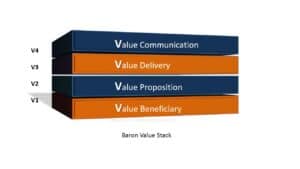Focusing on an extremely specific segment of an industry can be a highly successful distinctive competency. But, every time I tell a client to get more specific, I have an all-too-common conversation.
It would typically start like this:
“I appreciate your recommendation to focus on a more specific target market…”
I knew what was coming next. I’d heard it before—too many times before. But I let them continue.
“…but I don’t want to miss any chance to sell our products to the largest number of possible customers.”
Yep. That’s what I knew he would say.
As a strategic consultant for years, I was far too familiar with FOMO – the fear of missing out on growth opportunities.
As a consulting firm that works with B2B companies to accelerate profitable growth, one of the biggest myths we need to help overcome is the concern that getting specific can limit growth.
After all, there are so many markets we can serve that we would be foolish to turn down revenue.
In fact, the reverse is true. Research from leading business schools has shown that the leaders delivering differentiated customer value outgrow competitors by 1.5 to 3 times. As Pragmatic Institute teaches, we want to select markets where there is an urgent need that is pervasive and there exists a willingness to pay.
This article originated as an email I send to clients who are afraid to define their markets with enough granularity that it matters.
I am a tennis fanatic and play competitively as often as I can. Recently, I attended the virtual global tennis summit.
To give you a sense of the event’s magnitude, Rick Macci (the coach who helped develop Venus and Serena Williams, among other superstars) was one of many famous speakers.
In addition to this line-up of world-renowned coaches, a physical therapist from the US, Emma Green, gave a very well-received presentation.
Emma bills herself as the “tennis elbow queen.” If Emma was “just another physical therapist,” I doubt she would have had a speaking slot at this prestigious event.
So what has this got to do with B2B companies?
Given that so many companies struggle to differentiate themselves, they can learn much from Emma.
- Focus is a competitive advantage: Rather than focus on all types of injuries that PTs address, Emma chose a specific focus area that aligned well with her expertise.
- Your product should be in a space where people will pay to solve their problem: Tennis elbow is a persistent, nagging, painful problem many people have. It has a serious negative impact on their lives. As a result, people want to resolve this issue urgently and are willing to pay to resolve it.
- Authenticity is the best brand: Emma has done a great job of marketing herself. Fortunately, her last name Green and queen rhyme. Phrases in that verse are much easier to remember. I had no issue remembering her name. However, I can’t imagine many executives wearing a purple robe. Instead, promote yourself in ways that work for you.
- Specializing will help you stand out: She was not afraid to “restrict” her marketing and practice to tennis elbow. Most PTs are trained to treat feet, backs, legs, etc in addition to elbows. However, if Emma decided to treat all potential issues, she would be “just another PT.” And not someone sharing the virtual stage with Rick Macci and others.
- People love brands that are generous with their specific knowledge: On her website is a ton of content on tennis elbow. She gives away a free secret exercise in exchange for an email address to build her list.
- Excellent customer experiences lead to excellent reviews: She also has lots of testimonials from satisfied clients. She told lots of success stories during her presentation.
- Passion for the problem is key to engaging with prospects: She truly has a ton of expertise on tennis elbow. She easily and compellingly spoke about tennis elbow for 90 minutes and could have gone much longer.
- Being specific doesn’t mean you can’t be creative in defining your customer: Emma seems to restrict herself but not really. Tennis elbow afflicts thousands of people. And she has “expanded” beyond tennis elbow to address golfers’ elbow (pain on the inside of the elbow). Tennis elbow impacts tennis players, golfers, throwers, drummers and other musicians. The market is pretty large in actuality.
- Being specific also doesn’t mean you can’t explore the entire environment affecting the problem: She also views the solution to tennis elbow as requiring treatment for things beyond the elbow. She talked about how shoulder and neck issues can exacerbate elbow problems, so treating these body parts is essential too. She also talked about the mind-body connection to tennis elbow. All of this gives her permission to talk about other things besides the elbow.
- Partners are key to growth: she didn’t have to put on the event herself, but she made herself known to the right people, so she got invited to speak at this premier event. Participation cost her nothing besides the time to present and follow-up leads.
I’m sure that she got lots of leads from her talk. And the other speakers have contacts and students with tennis elbows. I forwarded her to talk to a couple of my friends. I didn’t do this to help Emma, I did it to help my friends and they both thanked me a lot.
At Baron Strategic Partners, we talk to our clients about the four steps of customer value creation.
- Identify the value beneficiary- namely those people and organizations that get the most value from your offering. For Emma, it is the thousands of people who suffer from tennis elbow.
- Articulate your value proposition to the value beneficiary- Emma’s value proposition is that she helps people with tennis elbow get their life back and enable them to rejoin the activities they enjoy.
- Design your value delivery system- Emma ensures she can deliver her promised value proposition by becoming an expert in treating tennis elbow.
- Communicate your value proposition to the value beneficiary- Emma, through her writings, her book and her presentations at events like the tennis summit, has spread the word about her tennis elbow expertise. Her presentations are a win for the summit, a win for the attendees and a win for Emma.
Most companies fail to articulate the four steps of customer value creation as effectively as Emma. As a result, they struggle with the perceived commoditization of their offerings and resort to discounting as a source of differentiation. They also fail to achieve and promote a distinctive competency.
There is a lot to learn from Emma’s positioning and target market selection. If you ever have tennis elbow, you know who to contact.
Foundations
Learn how to develop an understanding of your market and effectively share that information throughout the organization.
Students learn how to become market-driven by exploring concepts such as how to uncover strategic opportunities, define product team roles and responsibilities, prioritize actual vs. desired business goals and how to talk to and observe the market in action.
Author
-

Neil Baron, a stalwart in product marketing and management, boasts 36 years of industry experience. Having contributed significantly at Sybase, Art Technology Group, Babson College, ATMI, and Baron Strategic Partners, he excels in innovation, value proposition, and technology commercialization. Neil is adept at solution selling, services marketing, and consultative selling. For questions or inquiries, please contact [email protected].
View all posts









